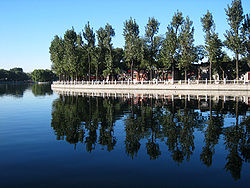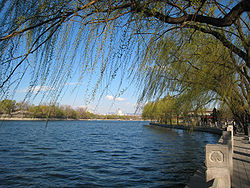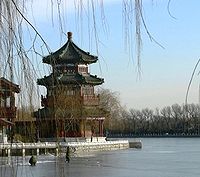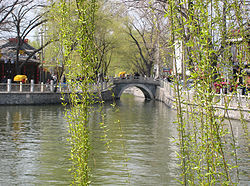
Shichahai
Encyclopedia




Beijing
Beijing , also known as Peking , is the capital of the People's Republic of China and one of the most populous cities in the world, with a population of 19,612,368 as of 2010. The city is the country's political, cultural, and educational center, and home to the headquarters for most of China's...
in China
China
Chinese civilization may refer to:* China for more general discussion of the country.* Chinese culture* Greater China, the transnational community of ethnic Chinese.* History of China* Sinosphere, the area historically affected by Chinese culture...
. They are located to the north-west of the Forbidden City
Forbidden City
The Forbidden City was the Chinese imperial palace from the Ming Dynasty to the end of the Qing Dynasty. It is located in the middle of Beijing, China, and now houses the Palace Museum...
and north-west of the Beihai Lake
Beihai Park
Beihai Park is an imperial garden to the northwest of the Forbidden City in Beijing. First built in the 10th century, it is amongst the largest of Chinese gardens, and contains numerous historically important structures, palaces and temples. Since 1925, the place has been open to the public as a...
. Shichahai consists of the following three lakes: Qianhai (前海), Xihai (西海) and Houhai
Houhai
Houhai is a lake and its surrounding district in central Beijing, one of the three parts of Shichahai. In recent years it has become famous for nightlife because it is home to many popular restaurants, bars, and cafes....
(后海). In imperial times it was called the Riverbank .
Description
Shichahai consists of 147 hectares and dates back to the Jin DynastyJin Dynasty, 1115–1234
The Jīn Dynasty ; Khitan language: Nik, Niku; ; 1115–1234), also known as the Jurchen Dynasty, was founded by the Wanyan clan of the Jurchens, the ancestors of the Manchus who established the Qing Dynasty some 500 years later...
. From the time of the Yuan Dynasty
Yuan Dynasty
The Yuan Dynasty , or Great Yuan Empire was a ruling dynasty founded by the Mongol leader Kublai Khan, who ruled most of present-day China, all of modern Mongolia and its surrounding areas, lasting officially from 1271 to 1368. It is considered both as a division of the Mongol Empire and as an...
it was the northernmost part of the Grand Canal
Grand Canal of China
The Grand Canal in China, also known as the Beijing-Hangzhou Grand Canal is the longest canal or artificial river in the world. Starting at Beijing, it passes through Tianjin and the provinces of Hebei, Shandong, Jiangsu and Zhejiang to the city of Hangzhou...
linking Hangzhou
Hangzhou
Hangzhou , formerly transliterated as Hangchow, is the capital and largest city of Zhejiang Province in Eastern China. Governed as a sub-provincial city, and as of 2010, its entire administrative division or prefecture had a registered population of 8.7 million people...
in the south to Beijing in the North of China. Because of this, the Shichahai area used to be the most important commercial district with all kinds of activities going on. It harbors several temples and mansions.
Around the lake there are ten famous Taoist and Buddhist temples and several formal royal mansions and gardens. The most well known are the Prince Gong Mansion
Prince Gong Mansion
The Prince Gong's Mansion or Gong Wang Fu Museum is located in the western part of central Beijing, China, north of the Shichahai Lake...
(恭亲王府) and the Prince Chun Mansion
Prince Chun Mansion
The Prince Chun Mansion is a large residence mansion in the siheyuan style and garden located near the Shichahai in central Beijing. Originally it was the lavish residence house of Prince Chun, now the mansion is a public museum and opens to visitors all year around....
(醇亲王府).
The borders of the lakes are surrounded by large trees.
Shichahai is a famous scenic spot in Beijing, and it is near the north-gate of the Beihai Park
Beihai Park
Beihai Park is an imperial garden to the northwest of the Forbidden City in Beijing. First built in the 10th century, it is amongst the largest of Chinese gardens, and contains numerous historically important structures, palaces and temples. Since 1925, the place has been open to the public as a...
.
In the summer tourists can rent boats to peddle on the lakes. In the winter many people come to ice-skate.
In 1992 the municipal government of Beijing declared the district an "Historical and Cultural Scenic District".
Nearby famous places
- Prince Gong MansionPrince Gong MansionThe Prince Gong's Mansion or Gong Wang Fu Museum is located in the western part of central Beijing, China, north of the Shichahai Lake...
- Prince Chun MansionPrince Chun MansionThe Prince Chun Mansion is a large residence mansion in the siheyuan style and garden located near the Shichahai in central Beijing. Originally it was the lavish residence house of Prince Chun, now the mansion is a public museum and opens to visitors all year around....
- Former Residence of Soong Ching-lingFormer Residence of Soong Ching-lingThe Former Residence of Soong Ching Ling is a museum in the Shichahai area of Beijing and once was the last residence of Soong Ching-ling, the wife of Sun Yat-sen and later the Honorary Chairman of the People’s Republic of China...
- Former residence of Chinese writer Guo MoruoGuo MoruoGuo Moruo , courtesy name Dingtang , was a Chinese author, poet, historian, archaeologist, and government official from Sichuan, China.-Family history:Guo, originally named Guo Kaizhen, was born on November 10 or 16, in the small town of Shawan...
- Typical Chinese hutongHutongHutongs are a type of narrow streets or alleys, most commonly associated with Beijing, China.In Beijing, hutongs are alleys formed by lines of siheyuan, traditional courtyard residences. Many neighbourhoods were formed by joining one siheyuan to another to form a hutong, and then joining one...
streets, with typical siheyuanSiheyuanA siheyuan is a historical type of residence that was commonly found throughout China, most famously in Beijing. In English, siheyuan are sometimes referred to as Chinese quadrangles. The name literally means a courtyard surrounded by four buildings...
courtyard houses. - Drum Tower and Bell TowerGulou and ZhonglouGǔlóu , the drum tower of Beijing, is situated at the northern end of the central axis of the Inner City to the north of Di’ anmen Street. Originally built for musical reasons, it was later used to announce the time and is now a tourist attraction....

